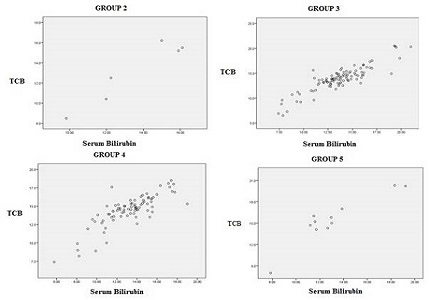Accuracy of transcutaneous bilirubinometer in assessing jaundice in newborns in Indian context
Abstract
Background: Jaundice is a very common problem in newborns. Though measuring serum bilirubin is considered the gold standard method for estimating jaundice, Transcutaneous Bilirubin (TCB) measurement by TCB meter is now used in various centers. The accuracy of TCB meter is affected by many factors, skin colour being one of them.
Aim: To analyze the accuracy of TCB meter in comparison to serum bilirubin for assessing jaundice in babies with different skin colours, in a tertiary care centre in South India.
Methods: The study was performed in 200 babies in a medical college, in South India over a period of five months from august 2016 to December 2016. Term babies upto 7th post natal day without any complications were analyzed. Babies were categorized based on their skin colour into 6 groups using the Fitz Patrick’s colour scale. Jaundice was quantified in these babies by TCB meter and by measuring serum bilirubin at the same time and the values were compared.
Results: Out of 200 babies, 6 babies were in group 2, 100 in group 3, 83 in group 4 and 11 in group 5. Though the Pearson correlation was linear in all the groups, it was lesser in the dark skinned babies. So we concluded that assessment of jaundice by TCB meter is not accurate in dark skinned babies. Hence serum bilirubin must be done in these babies before intervention.
Conclusion: TCB is not accurate in assessing jaundice in dark skinned babies. Still it can be used as a valid screening tool.
Downloads
References
2. Maisels MJ, Ostrea EM Jr, Touch S, Clune SE, Cepeda E, Kring E, Gracey K, Jackson C, Talbot D, Huang R. Evaluation of a new transcutaneous bilirubinometer. Pediatrics. 2004 Jun;113(6):1628-35. [PubMed]
3. Tan KL, Chia HP, Koh BC. Transcutaneous bilirubinometry in Chinese, Malay and Indian infants. Acta Paediatr.1996 Aug;85(8):986-90.
4. Maisels MJ, Kring E. Transcutaneous bilirubinometry decreases the need for serum bilirubin measurements and saves money. Pediatrics. 1997 Apr;99(4):599-601.doi: 10.1542/peds.99.4.599.
5. Knudsen A, Ebbesen R. Transcutaneous bilirubinometry in neonatal intensive care units. Arch Dis Child Fetal Neonatal Ed. 1996 Jul;75(1):F53-56.doi: 10.1136/fn.75.1.F53.
6. Grande R, Gutierrez E, Latorre E, Arguelles F. Physiological variations in the pigmentation of newborn infants. Hum Biol. 1994 Jun;66(3):495-507.
7. Onks D, Silverman L, Robertson A. Effect of melanin, oxyhemoglobin and bilirubin on transcutaneous bilirubinometry. Acta Paediatr. 1993 Jan;82(1):19-21. [PubMed]
8. Wang L, Jacques SL, Zheng L. MCML--Monte Carlo modeling of light transport in multi-layered tissues. Comput Methods Programs Biomed. 1995 Jul;47(2):131-46. [PubMed]
9. Jacques SL. Path integral description of light transport in tissue. Ann N Y Acad Sci. 1998 Feb 9;838:1-13.
10. Szabo P, Wolf M, Bucher HU, Fauchère JC, Haensse D, Arlettaz R. Detection of hyperbilirubinaemia in jaundiced full-term neonates by eye or by bilirubinometer? Eur J Pediatr. 2004 Dec;163(12):722-7. [PubMed]
11. Dai J, Parry DM, Krahn J. Transcutaneous bilirubinometry: its role in the assessment of neonatal jaundice. Clin Biochem. 1997 Feb;30(1):1-9.
12. Beck M, Kau N, Schlebusch H. Transcutaneous bilirubin measurement in newborn infants: evaluation of a new spectrophotometric method. Arch Dis Child Fetal Neonatal Ed. 2003 Jul; 88(4):F350-351. doi: 10.1136/fn.88.4.F350-b.
13. Bhutani VK, Gourley GR, Adler S, Kreamer B, Dalin C, Johnson LH. Noninvasive measurement of total serum bilirubin in a multiracial predischarge newborn population to assess the risk of severe hyperbilirubinemia. Pediatrics. 2000 Aug;106(2):E17.
14. Afanetti M, Eleni Dit Trolli S, Yousef N, Jrad I, Mokhtari M. Transcutaneous bilirubinometry is not influenced by term or skin color in neonates. Early Hum Dev. 2014 Aug;90(8):417-20. doi: 10.1016/j.earlhumdev.2014.05.009. Epub 2014 Jun 11.
15. Samiee-Zafarghandy S, Feberova J, Williams K, Yasseen AS, Perkins SL, Lemyre B. Influence of skin colour on diagnostic accuracy of the jaundice meter JM 103 in newborns. Arch Dis Child Fetal Neonatal Ed. 2014 Nov;99(6):F480-4. doi: 10.1136/archdischild-2013-305699. Epub 2014 Jul 29.

Copyright (c) 2017 Author (s). Published by Siddharth Health Research and Social Welfare Society

This work is licensed under a Creative Commons Attribution 4.0 International License.


 OAI - Open Archives Initiative
OAI - Open Archives Initiative


